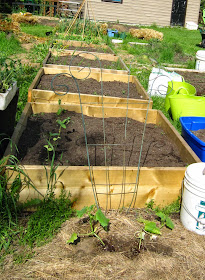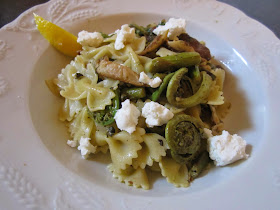It's always nice to go old school and make some fried rice to use up leftovers. This is easy to make if you don't do a lot of cooking. I've been really into brown rice lately and it works perfectly well in this dish (as well as this
cheesy zucchini rice I made a little while ago).
Throw in some shrimp or chicken and you've got a quick and healthy meal.
A good tip is to chop all of the ingredients around the same size - pea size. So the peppers, onions and mushrooms need to get diced pretty small.
 Ingredients:
Ingredients:
2 eggs, lightly beaten
Sesame oil
2-3 pieces bacon, chopped
4 small garlic cloves, minced
1 tsp minced ginger
1 leek (or 1 medium onion), diced
2 peppers (orange/red), diced
1 1/2 cups diced mushrooms
2 cups brown rice, cooked, chilled
3/4 cup frozen green peas
Sauce (recipe follows)
1/2 cup bean sprouts (optional)
1/4 cup cilantro (optional)
Sauce
Mix together 2 Tbsp light soy sauce, 1 tsp black vinegar and 1 Tbsp shaoxing cooking wine (or beer works perfectly well if you don't have the wine). Set aside until ready to use.
Method
In a heated non-stick saute pan, add two dashes of sesame oil then pour in the eggs. Rotate the pan a bit to allow the eggs to cover the entire pan bottom in a thin sheet. Cook until most of the raw is done (but don't overcook). Roll out onto a plate and set aside. Roughly chop (just use your wooden spoon to break it up a bit).
In same pan, add bacon. Cook until done, but not too crispy. Remove from pan with a slotted spoon to keep the fat.

Add garlic, ginger and onions/leeks and cook just 2 minutes. Add peppers and mushrooms. Saute while stirring fairly often until vegetables have softened.

Add cooked rice and the sauce. Cook until rice is fully heated through.
Add green peas, sprouts and cilantro (if using), reserved bacon and egg. Turn over with wooden spoon to mix all ingredients together. Remove from heat and cover with lid until ready to serve. Should sit just a few minutes until peas have heated through.
Garnish with more cilantro, maybe sliced spring onions. Serve with additional sesame oil or soy.
 I don't normally clean mushrooms too much but in this case they seemed awfully dirty. Just wipe them with a damp paper towel to clean.
I don't normally clean mushrooms too much but in this case they seemed awfully dirty. Just wipe them with a damp paper towel to clean.























































